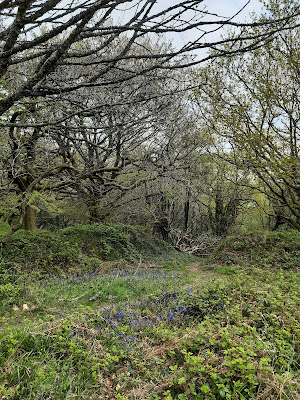It was a dark day in mid-February when I arrived home from a morning out with my sons to the news that our friend, Chris Palmer, had had a brain haemorrhage and was undergoing an operation in hospital. As the days have lengthened and the light has come back, my delight in the renewal of spring has been tempered by worry and feelings of helplessness towards Chris and her wife, Jinny; how they were and what was going to happen, as hope ebbed and flowed. Like many others, I carried them with me everywhere I went.
On Wednesday night came the news that Chris had died. Yesterday I drove up to Symonds Yat, wanting to be by the river, in nature, on the edge of one land and another. I thought there might be solace there, but didn't find it. (There were maps, but they can be hard to read.)
Chris was a leatherworker, an artist and a writer, with a profound empathy for the natural world. She was the sort of person who, if you were lucky enough to make a connection with her - and so many were - she would open her life to you and it would feel like a homecoming. When I think of who she was, I can see she was the epitome of an old soul, countering more than her share of tribulation with the unrelenting beauty that permeated her work, and an attitude of curiosity, gentleness and fun.
The satchel of poetry
I felt quite desolate when she and Jinny left the west end of the Kennet & Avon canal a few years ago and travelled east and then north-west on NB Netty to be nearer family, but it was easy to stay connected, through discussions about poetry and our MA studies at Manchester Writing School with Jinny, and through Chris's wonderful art and the entertaining blog she'd post daily on Skyravenwolf's Facebook page, where she had a devoted following. Chris and I would message too, from
time to time, occasionally addressing a painful set of circumstances we had in
common with each other. There were no answers for either of us, but I found
comfort in our communion, and came to understand that the inability to resolve
this particular issue is not necessarily the disaster I'd previously imagined
it to be. Ultimately the responsibility we have is to our own lives, and Chris
met that responsibility head on, day after day, regardless of any troubles she
might have had. In this she has shown me how to live.
We all wanted Chris to be restored to us. We wanted more evidence of how wondrous life was to shore up our own existences. More beauty, more beauty, we cried, open-beaked and demanding. But I think Chris had learnt her lesson for this lifetime so well, she was, in the end, complete. The Finished Chris.
At the same time, I realise how this conclusion is scant comfort for those who were closer to her than me, who now have a void punched through every minute of every day.
People say rest well at this point, don't they, but I'm going to wish for strength and ease in joint and sinew, and enough leather, tools, paper and paints to keep Chris happy and occupied until the rest of us catch her up.




.JPG)
.JPG)


































































